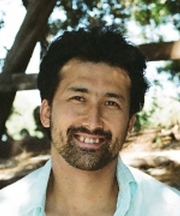 |
Dr. Denis Sheynikhovich (Associate Professor Sorbonne Université)Vision Institute
Aging in Vision and Action Lab
CNRS – INSERM – University Pierre&Marie Curie 17, rue Moreau F-75012 Paris, France Phone: +33 (0)1 53 46 26 55
email:
|
My research work focuses on computational modeling of neural mechanisms supporting spatial memory and behavior. My main subjects of interest are the following:
Linking neural activity in the hippocampal formation and spatial behavior.
The hippocampal formation contains different types of neurons, the activity of which is highly correlated with spatial location of a navigating animal. Is it true that the activity of these neurons represents the animal’s memory about where it is? If yes, then behavioral decisions of this animal must be determined (at least in part) by the activity of those neurons. I am interested in reconciling the neural data and behavior of animals by means of computational modeling. In my doctoral thesis, a system-level model of rodent navigation has been proposed that provided a link between firing properties of location-sensitive neurons in the hippocampal formation and behavioral decisions made by rats in several spatial navigation tasks [1]. Main contributions of this work concern the interaction between grid cells and place cells in the hippocampal formation, implementation of different navigational strategies and the existence of a `geometric module‘ in the rat’s brain.
Implementation of navigational strategies in the brain
Goal-oriented spatial behavior can be expressed in a number of different navigational strategies. These are, for example, simple stimulus-response behaviors such as approaching a landmark, and more complex strategies involving mental mapping and planning. Different memory representations support those strategies, e.g. visual memory of a landmark is sufficient to approach it, whereas a mental map, potentially combining many landmarks and their spatial relations, is required to plan a trajectory. The question I am interested in is how a suitable strategy (and the corresponding memory representation) is chosen depending on task requirements? We have proposed a simple model of strategy switching, in which strategies are chosen based on their past performance [2,3]. According to some experimental evidence, the prefrontal cortex is responsible for evaluation of different strategies and switching between them.
The role of neuromodulator dopamine for long-term memory in the prefrontal cortex
In order to learn a goal-oriented strategy and use it efficiently, a long-term memory is required. According to to a large body of evidence, goal information is delivered to various brain areas by neuromodulator dopamine. I am interested in the neural mechanisms of dopamine influence on long-term memory in prefrontal cortex neurons [4]. In particular, on the basis of neuro-physiological studies we proposed a model of synaptic plasticity in prefrontal cortex neurons under the influence of dopamine.
The role of aging in visual information processing during spatial navigation
The new focus of my work concerns the influence of neural aging on the brain’s spatial navigation network. Via a variety of neural processing stages visual information from the retina arrives to the hippocampal formation, where it is combined with other multi-modal sensory signals to produce an internal spatial representation. Even in a healthy individual the quality of such a representation gets worse with age. What is the contribution of purely visual aging in this age-related impairment ? Can this impairment be explained by age-related changes in synaptic plasticity, as it seems to be the case in rodents ? What could be the role of neuronal noise in this impairment ? In the recently created laboratory at the Vision Institute we will try to address these questions by combining computational modeling, psychophysical and behavioral experiments in humans.
Keywords: spatial memory, spatial behavior, neural networks, computational modeling, spiking neurons, learning and synaptic plasticity, place cells, cognitive map, reinforcement learning, vision, healthy aging.
Bibliometry
CV (pdf): [ download ]
Thesis (pdf): [ download ]
List of main publication (pdf): [ download ]
Order by Year - CategoryPublications
Show All - Journals - Peer-reviewed conference proceedings - Others2012
2010
2009
2007
2005
1996